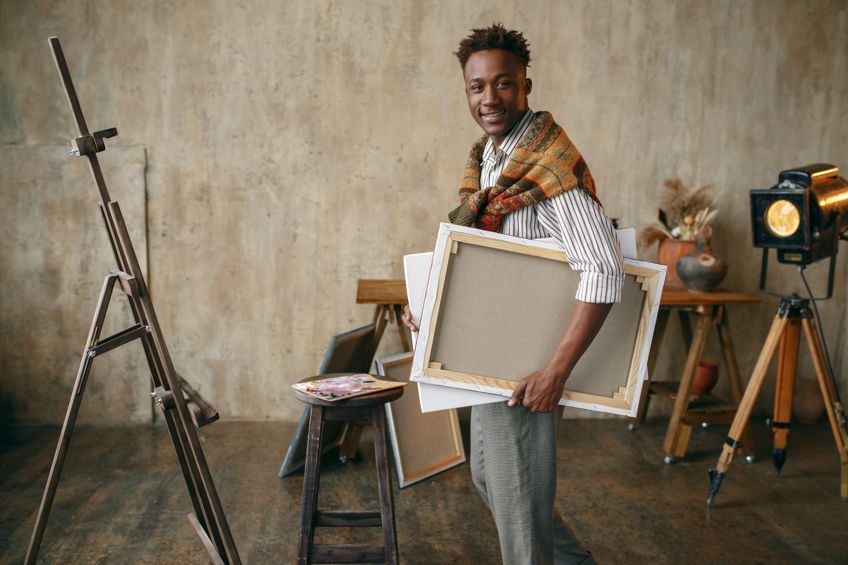The inherently diverse and dynamic studio arts are a pivotal facet of the cultural and creative industries. Studio arts encompass various artistic practices, such as painting, sculpture, printmaking, ceramics, photography, and more. These practices require technical skill and creative expression, making them essential to developing cultural and personal identities. Understanding studio arts can provide insight into the creative process and help individuals navigate the ever-evolving landscape of art and culture.
This guide aims to shed light on the intricacies and nuances of studio arts, underscoring their significance in cultivating an appreciation for aesthetic expression and creative prowess. Read on to learn more about the fascinating world of studio arts.
What is Studio Arts?
Definition and Significance of Studio Arts
Studio Arts refers to an array of artistic practices that are traditionally created in a studio setting, such as painting, drawing, sculpture, printmaking, ceramics, photography, and more. Unlike other forms of art, studio art typically involves the creation of unique, tangible objects that bear the direct imprint of an artist’s skills, vision, and emotion.
The significance of studio art in the world of art is immense. Firstly, they offer a tangible manifestation of an artist’s creative process , showcasing their technical skills, artistic vision, and unique interpretation of their environment. Secondly, the diverse practices within studio arts provide a broad spectrum of aesthetic experiences, allowing for a wide range of artistic expressions and interpretations.
Lastly, studio arts contribute to cultural and personal identity formation , acting as a mirror reflecting societal changes and a tool for individuals to express their feelings and experiences. Thus, understanding and appreciating studio arts is integral to comprehending the evolving landscape of art and culture.
The Evolution and History of Studio Arts

The history of studio arts is a rich tapestry woven with the threads of countless artistic movements and individual artists’ contributions. The origins of studio arts as a discipline can be traced back to the Renaissance, a period marked by profound advancements in artistic techniques and a burgeoning acknowledgment of artists as skilled craftsmen.
During the Renaissance , artists like Leonardo da Vinci and Michelangelo began to establish spaces dedicated to creating art – the predecessors of modern-day studios. These studios were not simply places of production; they served as incubators of creativity, where artists engaged in philosophical dialogues, honed their skills, and pushed the boundaries of artistic expression.
The 19th and 20th centuries ushered in unprecedented changes in the world of studio arts. Artists started to break away from traditional norms and techniques, experimenting with new forms and mediums. The Impressionist movement, led by artists like Monet and Renoir, rejected the rigid rules of realism, favoring instead the capture of fleeting moments and the interplay of light and color. The explosion of many artistic movements, such as abstract expressionism, pop art, and conceptual art, followed this.
Studio arts continue to evolve in the contemporary era, embracing interdisciplinary practices and digital technology promoting art . Digital art software has democratized artistic creation, allowing anyone with a computer to experiment with art-making. Meanwhile, many artists are blurring the boundaries between different art forms, combining painting, sculpture, installation, and performance to create immersive and interactive art experiences.
Thus, the history and evolution of studio arts reflect the ongoing human quest for self-expression and understanding, revealing the shifting cultural and societal landscapes throughout the ages.
Forms and Mediums within Studio Arts
Studio arts is a broad term that encompasses a variety of different forms and mediums. Here, we delve into some of the main categories:
Painting
Painting is one of the most traditional forms of studio art. It involves applying pigment to a substrate (such as canvas, paper, or wood) using brushes or other tools. There are various types of painting, including oil, acrylic, and watercolor, each with its unique characteristics and techniques.
Sculpture

Sculpture is a three-dimensional form of artistic expression. Sculptors use clay, stone, metal, or wood to create objects of varying shapes and sizes. The process can involve techniques like carving, modeling, casting, or welding.
Ceramics
Ceramics is the art of making objects from clay or other ceramic materials, fired at high temperatures to become stiff and durable. The process includes hand-building, wheel-throwing, casting, and glazing.
Photography
Photography, a relatively modern form of studio media arts , involves capturing images with a camera to express an idea, tell a story, or document a reality. It can be digital or film-based, encompassing several genres, such as portrait, landscape, documentary, and abstract photography.
Printmaking
Printmaking involves creating artwork by printing, usually on paper. Printmaking covers a variety of techniques, including etching, lithography, screen-printing, and woodcut. Each technique has its unique process and aesthetic.
These forms and mediums are just a few examples of what falls under the studio arts umbrella. Each one provides a unique avenue of expression and requires a distinct set of skills and techniques. By exploring these different areas, artists can find their preferred medium and develop their unique artistic voice.
The Role of Creativity and Self-Expression in Studio Arts
Creativity and self-expression form the lifeblood of studio art. They drive artistic innovation and individuality, infusing life into artistic practices and allowing artists to communicate their unique perspectives and experiences.
At its core, creativity in studio arts involves thinking outside the box and pushing the boundaries of traditional artistic conventions. It’s about experimenting with different mediums, techniques, and styles to create truly original and groundbreaking pieces. Whether it’s through the bold use of color, innovative manipulation of materials, or the incorporation of unconventional symbols and motifs, creativity in studio arts manifests in endless ways.
Coupled with creativity, self-expression is a fundamental aspect of the studio arts. Many artists’ work serves to convey their thoughts, feelings, and experiences to the world. Each stroke of the brush, each molded piece of clay, and each captured photograph can reflect the artist’s inner world, encapsulating their emotions, beliefs, and perceptions.
Creativity and self-expression are not merely aspects of studio arts – they are the defining characteristics of the discipline. They allow artists to break away from the norm, challenge the status quo, and express their individuality. As such, appreciating studio arts involves recognizing the value of creativity and self-expression and understanding these elements’ profound impact on the evolution of art and culture.
Educational and Career Opportunities in Studio Arts
Studio arts offer a plethora of educational and career opportunities for those passionate about artistic expression and creativity.
Educational Opportunities
Many institutions worldwide provide specialized programs in studio arts, ranging from diploma and undergraduate degree courses to postgraduate and doctoral studies. These programs offer comprehensive training in various artistic practices, allowing students to explore and specialize in their area of interest. Courses typically combine practical studio work with theoretical study, enabling students to develop their technical skills and understanding of art history and theory.
Aside from formal education, myriad workshops, short courses, and online learning platforms offer training in specific areas of studio arts. These flexible learning opportunities allow individuals to enhance their skills, learn new techniques, and engage with a community of fellow artists.
Career Opportunities
The dynamic nature of studio arts opens up a broad horizon of career possibilities . Of course, many aspire to become practicing artists, creating and selling their own work. However, that’s just the tip of the iceberg.
Studio artists can also find employment in many related fields. For instance, they could become art educators, teaching their craft in schools, community centers, or private workshops. They could work as curators or gallery administrators, engaging with the business and organizational side of the art world. Art therapy is another promising field where artists use the creative process to facilitate personal growth and healing.
In the digital age, studio art skills are also highly sought after in industries like advertising, design, photography, and animation. Artists can work as illustrators, graphic designers, photographers, or art directors, combining their artistic prowess with digital technology to create compelling visual content.
Moreover, numerous artists find success as freelancers or entrepreneurs, working on commissioned pieces, selling their work online, or running their own galleries or art-related businesses.
Notable Artists and Movements in Studio Arts
The history of studio arts is studded with illustrious artists and movements that have greatly influenced the discipline’s evolution and shaped its current landscape.
Notable Artists

- Leonardo da Vinci: An archetype of the Renaissance artist-scientist, da Vinci’s work encompasses painting, sculpture, architecture, anatomy, and engineering. His masterpieces, such as ‘The Mona Lisa’ and ‘The Last Supper’, are renowned for their intricate detail and innovative techniques.
- Michelangelo: Another towering figure of the Renaissance, Michelangelo was a master sculptor, painter, and architect. His works, such as the ‘David’ sculpture and the ceiling of the Sistine Chapel, are celebrated for their monumental scale and emotional intensity.
- Pablo Picasso: A key figure in the 20th-century art scene, Picasso co-founded the Cubist movement and made significant contributions to Symbolism and Surrealism. Works such as ‘Les Demoiselles d’Avignon’ and ‘Guernica’ are notable for their innovative use of form and perspective.
- Frida Kahlo: An iconic figure in modern art, Kahlo’s work is deeply personal, drawing on her experiences and emotions. Her self-portraits are celebrated for their vibrant color palette and symbolic imagery.
- Andy Warhol: A leading figure in the Pop Art movement, Warhol’s work explores the relationship between artistic expression, advertising, and celebrity culture. His silkscreen paintings of Campbell’s soup cans and Marilyn Monroe are among the most recognizable images in modern art.
Notable Movements
- Impressionism: Originating in the 19th century, Impressionism is characterized by small, thin brush strokes, accurate depictions of light, and unusual visual angles. Key artists include Claude Monet, Edgar Degas, and Pierre-Auguste Renoir.
- Cubism: Co-founded by Pablo Picasso and Georges Braque, Cubism is known for its fragmentation of the subject into geometric shapes, providing multiple viewpoints within one painting.
- Surrealism: This 20th-century movement, led by artists like Salvador Dali and Rene Magritte, aimed to unleash the creative potential of the unconscious mind, resulting in dreamlike, bizarre, and often unsettling imagery.
- Pop Art: Emerging in the mid-20th century, Pop Art drew inspiration from popular and commercial culture, including advertising, comic books, and mundane cultural objects. Key figures include Andy Warhol, Roy Lichtenstein, and Jasper Johns.
- Abstract Expressionism: A post-World War II art movement, Abstract Expressionism is characterized by gestures of paint application and the impression of spontaneity. Notable artists include Jackson Pollock, Mark Rothko, and Willem de Kooning.
These artists and movements made significant contributions to studio arts, pushing the boundaries of artistic expression and opening new avenues for creativity and innovation.
Bottom Line
Ultimately, studio arts are a testament to the ever-changing human experience and its expression through creative means. From traditional forms like painting and sculpture to contemporary digital technology practices, studio arts continue to evolve and shape people’s understanding of themselves and the world around them. Whether as artists, educators, or consumers of art, everyone can appreciate and celebrate the enduring power of studio art. So, continue to explore and support these diverse and dynamic disciplines, keeping the spirit of creativity and self-expression alive for generations to come.







